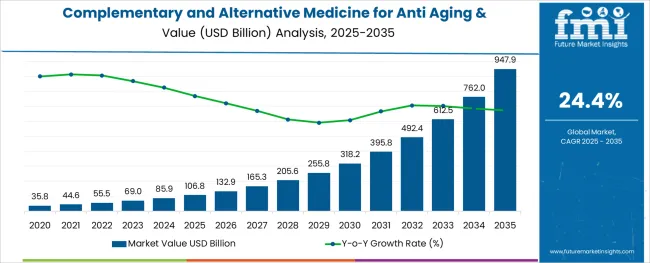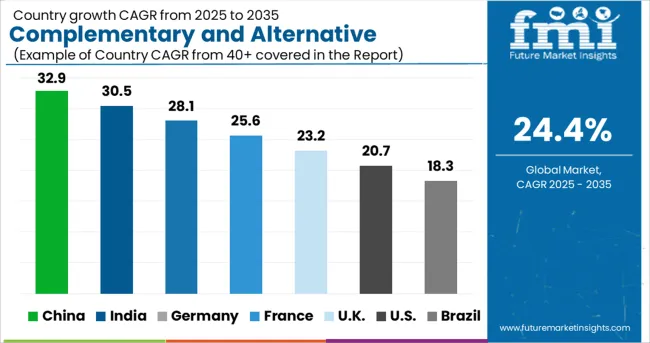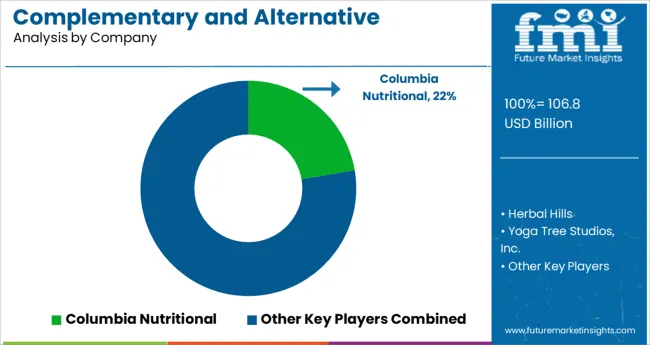The Complementary and Alternative Medicine for Anti Aging & Longetivity Market is estimated to be valued at USD 106.8 billion in 2025 and is projected to reach USD 947.9 billion by 2035, registering a compound annual growth rate (CAGR) of 24.4% over the forecast period.

The alginic acid market is undergoing consistent growth, propelled by rising demand from food processing, pharmaceutical formulations, and cosmetic applications. A growing focus on natural and sustainable ingredients in manufacturing processes has positioned alginic acid as a preferred biopolymer across industries.
The market is further supported by its diverse functional benefits, including water retention, gelling, and stabilizing properties, which make it indispensable in high-performance formulations. Increased regulatory acceptance of alginates as safe additives and the push towards cleaner labeling in food and personal care products have reinforced their adoption.
Ongoing innovation in extraction technologies and the utilization of algae as a renewable resource are paving the way for cost-effective production and expanded applications, ensuring sustained market expansion in the coming years.
The market is segmented by Intervention Type and Customer Type and region. By Intervention Type, the market is divided into Body Healing, Traditional Alternative Medicine/Traditional Alternative Medicine/Botanicals, Mind Healing, External Energy Healing, and Sensory Healing. In terms of Customer Type, the market is classified into High Net Worth (HNW) Individuals, Very High Net Worth (VHNW) Individuals, Ultra-high Net Worth (UHNW) Individuals, and Other Customer Types. Regionally, the market is classified into North America, Latin America, Western Europe, Eastern Europe, Balkan & Baltic Countries, Russia & Belarus, Central Asia, East Asia, South Asia & Pacific, and the Middle East & Africa.
When segmented by salts, sodium alginate is expected to command 27.5% of the market revenue in 2025, marking it as the leading subsegment in this category. This leadership has been driven by its superior solubility, ease of incorporation into formulations, and versatility in a wide range of applications.
Its ability to form stable gels and maintain viscosity under varying conditions has made it highly sought after in both food and pharmaceutical sectors. Manufacturers have prioritized sodium alginate due to its consistent performance, cost-effectiveness, and regulatory acceptance, which have collectively strengthened its position.
The segment’s prominence has also been enhanced by its adaptability to evolving consumer preferences for plant-derived and sustainable ingredients, reinforcing its market share.
Segmented by end user industry, the food industry is projected to hold 33.0% of the market revenue in 2025, positioning it as the most prominent sector. This dominance has been shaped by the industry’s increasing reliance on alginic acid and its derivatives to deliver desirable textures, stabilize emulsions, and improve shelf life of processed foods.
As consumer demand for clean label and natural additives has intensified, the food sector has responded by integrating alginates into bakery, dairy, and confectionery products. Enhanced production efficiency and compliance with food safety standards have further encouraged widespread use.
The segment’s leadership has also been supported by product differentiation strategies where alginates contribute to premium quality and innovation, securing their role in modern food formulations.
As per the Complementary and Alternative Medicine for Anti-Aging & Longevity Market industry research by Future Market Insights - a market research and competitive intelligence provider, historically, from 2020 to 2024, the market value of the Complementary and Alternative Medicine for Anti-Aging & Longevity increased at around 20.9% CAGR.
The Complementary and Alternative Medicine for Anti-Aging & Longevity Market is projected to grow at a CAGR of 24.4% over the coming ten years.
The market is expected to grow in the coming years as a result of the changing regulatory landscape and strong government initiatives, which have led to the establishment of strong transnational links across therapeutic paths that connect global, national, and local alternative medicine groups.
Furthermore, government activities examining standards relating to the right to health in all of its manifestations are expected to bolster consumers' participation and service providers in the field of CAM. Government actions, such as increased targeted spending, the establishment of government facilities, and the publication of guidelines to ensure the use of complementary and alternative medicine, all help to drive demand for integrative health and complementary medicine practices (CAM).
Medical tourism, which attracts people from all over the world and allows them to seek world-class alternative medical care, is also being promoted by regulatory organizations. In some Indian states, for example, regulatory authorities have invested significantly in the creation and standardization of alternative medical services. A government entity named the Ministry of Ayush has been established to oversee Yoga, Ayurveda, homeopathic, and naturopathy instruction, product creation, research, and other services in India.

In 2024, Europe dominated the global market, accounting for nearly 30% of total sales. In Europe, complementary and alternative medicine (CAM) has become significantly popular and well-accepted. Chiropractic, massage, homeopathy, reflexology, acupuncture, and herbal medicine are the most often used CAM therapies in Europe.
Women and people in their middle years are more likely to use complementary and alternative medicine (CAM). Musculoskeletal issues are the most common conditions addressed with complementary and alternative medicine (CAM) in terms of health determinants. Depression, severe headaches, back issues, stomach or intestinal diseases, and sleeplessness are the most common conditions linked to the use of complementary and alternative medicine.
Furthermore, Ayurveda is gaining popularity in several European countries, with Germany serving as the epicenter of Ayurveda and leading the way in the region, with Austria and Switzerland following suit. EUAA is a federation of educational institutions, Ayurvedic organizations, manufacturers, hospitals, distributors, therapists, and suppliers. The EUAA is a non-profit organization that represents 16 European Economic Area countries and institutions. The mission of the organization is to promote Ayurveda as a holistic medicine throughout the region.
Over the projected period, the market in the Middle East and Africa is expected to expand at the fastest pace. The long history of adopting spiritual approaches as well as herbal remedies to cure various ailments is projected to drive the regional market throughout the forecast period. In the coming years, Qatar is expected to be the region's fastest-growing market for mind-body therapies.

In 2024, the traditional alternative medicine or Traditional Alternative Medicine/Botanicals segment accounted for more than 30% of complementary and alternative medicine for anti-aging & longevity sales. Key players have been investing in CAM therapies since the regulatory rules for starting a business in this industry are less strict than for pharmaceutical enterprises. Government actions meanwhile, boost entrepreneur activity in the CAM domain.
Tai Chi is a type of relaxation exercise that assists older adults, especially those with Parkinson's disease, improve their stability, balance, and flexibility. According to a study released in 2024, in older people, the aggregate cerebral vascular hemodynamic index who practiced Tai Chi was similar to that of the young population and showed a substantial improvement when compared to older adults who did not practice Tai Chi.
The segment growth is being boosted by technological breakthroughs in sensory healing. HUSO, for example, is a sound therapy system that uses acupuncture meridians to control and harmonize the body, as well as a tone to cope with stress and harmful electromagnetic fields. Headphones and wrist and ankle padding are included in the product.
Consumer awareness about the benefits of complementary and alternative medicine goods is expected to grow, as is the adoption of innovative sensory healing technology in hospitals and clinics. However, as western medicine becomes more involved in the anti-aging and longevity business, the sector's expansion will be constrained.
Since several emerging economies perceive CAM products for antiaging and lifespan to be expensive and undercut the need for them, HNWs represent a lucrative consumer pool for complementary and alternative medicine for anti-aging & longevity. Individuals with high net worth in industrialized countries are more inclined than those in poor countries to spend money on complementary and alternative medicine for antiaging and longevity. The low opportunity cost and high social presence are the reasons behind this.
The global market is significantly competitive due to the existence of several companies. Key players focus on growth strategies such as improvement of existing technology, geographic expansion, product launch, and product approval to gain higher market share. Various development strategies help raise consumer awareness of new processes and products, such as product launches and collaborations.
The key players in the global Complementary and Alternative Medicine for Anti-Aging & Longevity market are Anadolu Medical Center, Sinomedica, Acupuncture Enfants, and Ayurveda Kuwait.
Some of the recent developments in complementary and alternative medicine for the anti-aging & longevity market are:
The global complementary and alternative medicine for anti aging & longetivity market is estimated to be valued at USD 106.8 billion in 2025.
It is projected to reach USD 947.9 billion by 2035.
The market is expected to grow at a 24.4% CAGR between 2025 and 2035.
The key product types are body healing, _yoga, _acupuncture & massage, _chiropractic, _qigong & tai chi, _kinesiology, _reflexology, _eurythmy, _other body healings, traditional alternative medicine/traditional alternative medicine/botanicals, _ayurveda, _naturopathic medicine, _traditional chinese medicine, _zang fu theory, _other traditional alternative medicine/traditional alternative medicine/botanicals, mind healing, _meditation & mindfulness, _relaxation, _other mind healings, external energy healing, _magnetic & electromagnetic therapy, _chakra healing, _reiki, _other external energy healings, sensory healing, _aromatherapy and _sound healing.
high net worth (hnw) individuals segment is expected to dominate with a 44.1% industry share in 2025.






Full Research Suite comprises of:
Market outlook & trends analysis
Interviews & case studies
Strategic recommendations
Vendor profiles & capabilities analysis
5-year forecasts
8 regions and 60+ country-level data splits
Market segment data splits
12 months of continuous data updates
DELIVERED AS:
PDF EXCEL ONLINE
Android Automotive OS (AAOS) Market Size and Share Forecast Outlook 2025 to 2035
Anderson Cascade Impactor Market Size and Share Forecast Outlook 2025 to 2035
Andersen-Tawil Syndrome Treatment Market Trends - Growth & Future Prospects 2025 to 2035
Andro Supplements Market
Handheld Electrostatic Meter Market Size and Share Forecast Outlook 2025 to 2035
Hand Towel Automatic Folding Machine Market Size and Share Forecast Outlook 2025 to 2035
Handheld Ultrasound Scanner Market Size and Share Forecast Outlook 2025 to 2035
Handheld Tagging Gun Market Forecast and Outlook 2025 to 2035
Sandwich Panel System Market Size and Share Forecast Outlook 2025 to 2035
Hand Tools Market Size and Share Forecast Outlook 2025 to 2035
Land Survey Equipment Market Size and Share Forecast Outlook 2025 to 2035
Handloom Product Market Size and Share Forecast Outlook 2025 to 2035
Band File Sander Belts Market Size and Share Forecast Outlook 2025 to 2035
Handheld XRF Analyzers Market Size and Share Forecast Outlook 2025 to 2035
Sand Abrasion Tester Market Size and Share Forecast Outlook 2025 to 2035
Sand Testing Equipments Market Size and Share Forecast Outlook 2025 to 2035
Landscape Lighting Market Size and Share Forecast Outlook 2025 to 2035
Handheld Police Radar Guns Market Size and Share Forecast Outlook 2025 to 2035
Handheld DNA Reader Market Size and Share Forecast Outlook 2025 to 2035
Handheld Robotic Navigation Market Analysis - Size, Share, and Forecast Outlook 2025 to 2035

Thank you!
You will receive an email from our Business Development Manager. Please be sure to check your SPAM/JUNK folder too.
Chat With
MaRIA